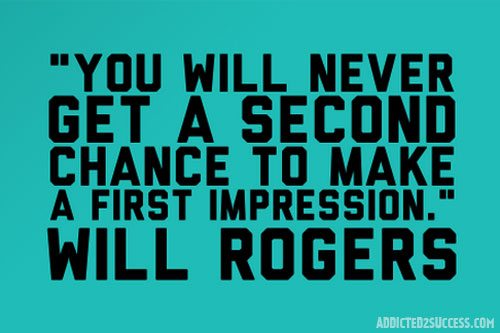Success Advice
4 Ways to Make A Great First Impression On Anyone

You only get one chance to make a great first impression.
No one will remember you, or pay you much attention if your first impression is so unmemorable. But there are many different ways to make sure you make a powerful, memorable first impression, and we’re going to look at four of the most effective methods.
Making A Great Impression
1. Design your elevator pitch
An elevator pitch is how you describe what you do for a living in a short amount of time, usually about thirty seconds. It’s called an elevator pitch because 30 seconds is the amount of time you will normally have to wait for an elevator. During that time it’s important that you can sum up what you do and how you do it. This is also useful in social situations when meeting people for the first time.
If you network with other business people, then along with your business card this is the most important way of getting your message across.
When starting a new business your main marketing tool is….YOU! By meeting people and speaking to them you are going to spread awareness of your business. When I first started working for myself, I had never heard of an elevator pitch or a 30 second story.
If someone asked me what I did I would undermine the importance of my business and be quite vague. This was because I was afraid of what other people would think and also because I hadn’t developed enough confidence in myself.
You don’t have to be starting or own your own business to benefit from having an elevator pitch. Write a thirty second script that you would say to someone when you meet them for the first time. Learning this off by heart can help you make a really good first impression. It’s very important that you deliver it with confidence as you won’t be saying it again to that particular person.
Since I developed my elevator pitch I have stopped sabotaging myself through introductions where I appeared nervous and lacking self-belief. Knowing my elevator speech well allows me to introduce myself with confidence and clarity and describe concisely what I do. You have to look as if you believe in yourself, and sound as if you believe in yourself, to enable others to believe in you too! You need to make it easy for them to connect with you.
2. Speak for Yourself
Sometimes you will be introduced to someone and the person who is making the introduction will do all the talking. If you are anxious or nervous then it is much easier to just stand there, smile and say Hi. In my own experience, I found that people don’t remember you if you don’t say anything and let the other person do all the talking. Speak for yourself.
After you have been introduced, make an effort to engage with that person with a question, for example, ‘do you come to these functions regularly?’ or give them some information about yourself. Try to ask open questions, beginning with ‘how do you….’ or ‘what do you feel about….’ When you really can’t think of anything to say, find something in common, or if you know a little about them, then use it to your advantage, for example ’Jim tells me you were born in Hawaii, what was growing up there like?’
Remember, most people love to talk about themselves!
3. Treat Everyone Like The Gatekeeper To Your Destiny
Joel Osteen, the American preacher and speaker, says that you should treat everyone like the gatekeeper to your destiny. What he means by this is that everyone you meet has the potential to change your life immeasurably and help you get to where you want to be. This is why it is vitally important to treat everyone the same and introduce yourself to as many people as possible, as you never know who will change your life for the better.
I recently met an old family friend whom I had not seen in many years. He did not recognise me and in the past I would have let my anxiety get the better of me and not said hello. These days, I am a lot more confident than I used to be, so I introduced myself and then used my elevator pitch to tell him what I am doing now.
I would have been happy with just the process of introducing myself and using my elevator pitch but the outcome of that chance meeting has been amazing and has provided me with huge opportunities. That is what I’ve found from introducing yourself well and using your elevator pitch. People will think of ways in which they can help you.
Try it out for yourself, and you will see more and more people will want to help you. Enthusiasm is infectious and people want to be a part of your success. You will also realise that there may be ways in which you can help other people and you might even be the gatekeeper to their destiny!
4. Body Language and Attitude
These are common sense tips that you probably already know but are easy to forget about and not to put into practice. Body posture is very important when you meet someone. The human brain will pick up many signals subconsciously from a meeting in a split second to help it form an opinion of you. You want to make sure you are giving off as many positive signals as possible.
Standing up straight is the most basic but the most important. When you stand up straight with your shoulders back you are giving the signal that you are confident in yourself. You also need to speak clearly and purposefully.
Your introduction and elevator pitch will have no impact if you mumble and look at the person’s shoes or over their shoulder. Always look people in the eyes. If you find this difficult then look at people’s eyebrows as they will think you are looking into their eyes. Make sure you smile throughout your meeting. Happiness and enthusiasm are infectious and attractive.
If you are anxious or nervous then meeting people may be difficult for you. It will help you immensely to control your breathing. Take slow deep breaths, this will help you to remain calm and be confident. Say to yourself “I’m calm and relaxed; I want to share who I am and what I do with others”.
If you believe in yourself and seem confident, enthusiastic and genuinely interested in the other person, then you will make a great first impression. Some people may not like you for reasons that are beyond your control, perhaps you remind them of someone or they are just simply having a bad day. If you have negative responses, don’t let this affect you. You are only in control of your own actions and thoughts. The outcomes of your meetings are out of your control so focus on the process!
The majority of the first meetings will be great and you will begin to attract new people into your life who want to help you and be friends with you.
If you have business cards then it’s best to carry them around with you everywhere you go as you never know who you could meet. Having a case is important to keep them in good condition. I’m not suggesting you give them out like confetti to everyone, but it’s important to have some to hand to give to the people who are interested or you think could make a difference to your business.
If you find introducing yourself difficult or you want to improve your first impression then a great way to do it is to practice. Go to a place where you can introduce yourself to someone. A networking event is a great place to meet lots of new people.
If you haven’t got an event coming up soon, practice by introducing yourself to the person serving you in the supermarket, in the bookstore, your neighbour, etc. You will learn something from every interaction especially the ones that are less than perfect.
I hope these tips will enable you to be your authentic, positive, confident self when meeting people and make memorable impressions at every opportunity.

Success Advice
How to Choose the Best Affiliate Programs for Your Blog
If you follow these steps, you can create an affiliate marketing plan that makes money, fits well with your content, and connects with your readers

Picking the right affiliate programs for your blog is really important. It can make a big difference in how much money you can make and how much your readers get out of your blog. With so many choices out there, deciding which ones to go with can be tricky.
This guide is here to make it easier for you. It will give you clear steps and helpful tips to choose affiliate programs that fit well with what your blog is about, what your readers like, and what you stand for.
For more articles on this theme, please head over to this blog https://blog.partners1xbet.com/.
Understanding Affiliate Marketing
Before you start picking affiliate programs, it’s important to really understand what affiliate marketing is and how it works.
Basically, affiliate marketing is when you promote a product or service on your blog, and then you get paid a little bit every time someone buys something or does something because you recommended it.
It’s great for both the person selling the product and the blogger, because the seller gets more sales with low risk, and the blogger can make money from their blog.
How to Choose the Right Affiliate Programs for Your Blog
1. Assess Your Niche and Audience
The key to doing well in affiliate marketing starts with really knowing what your blog is about and who reads it. Consider the following:
- Your blog’s content: What topics do you cover? Ensure the products or services you promote are relevant.
- Your audience’s interests and needs: What solutions are they seeking? Choose affiliate programs that offer products or services that solve their problems or enhance their lives.
2. Research Potential Affiliate Programs
Once you know what your blog is about and what your readers want, start looking for affiliate programs. Choose ones that are well-known for good products, great customer service, and helpful support for affiliates. Resources to find these programs include:
- Affiliate networks like ShareASale, Commission Junction, and ClickBank.
- Direct searches for “[Your Niche] affiliate programs” in search engines.
- Recommendations from other bloggers in your niche.
3. Evaluate the Commission Structure
The commission structure is a critical factor to consider. Look for programs that offer competitive rates that make your efforts worthwhile. Consider:
- The percentage of commission per sale.
- Whether the program offers a flat rate per action (e.g., per sign-up).
- The cookie duration, which affects how long after a click you can earn commissions on sales.
4. Consider the Program’s Reputation and Sureness
Join affiliate programs with a solid reputation for quality and sureness. This not only ensures that you’re promoting good products but also that you’ll be paid on time. You can:
- Read reviews from other affiliates.
- Check the program’s history and background.
- Look for any complaints or issues reported online.
5. Analyze the Support and Resources Offered
A good affiliate program gives you things like ads to use, training on their products, and helpful managers. Having access to these resources can really help you do a better job at promoting their products.
6. Understand the Terms and Conditions
Before signing up, thoroughly review the program’s terms and conditions. Pay close attention to:
- Payment thresholds and methods.
- Any restrictions on how you can promote their products.
- The program’s policy on affiliate marketing on social media platforms.
7. Test the Product or Service
If possible, test the product or service before promoting it. This firsthand experience allows you to offer genuine charge and build trust with your audience.
8. Look for Recurring Commission Opportunities
Some affiliate programs pay you again and again for subscriptions or services that charge fees regularly. These can provide a more stable income compared to one-time sales commissions.
Implementing Your Choice
After choosing the best affiliate programs, the next step is to smoothly include your affiliate marketing in your content plan. This includes:
- Creating valuable content that naturally incorporates affiliate links.
- Disclosing your affiliate affairs transparently to maintain trust with your audience.
- Tracking your results to understand what works best for your audience and adjusting your strategy accordingly.
Picking the best affiliate programs for your blog involves careful planning, research, and making sure they match what your audience likes and needs.
If you follow these steps, you can create an affiliate marketing plan that makes money, fits well with your content, and connects with your readers.
The real key to doing well with affiliate marketing isn’t just about the products you talk about, but also how much your audience trusts and values your advice.
With enough time, patience, and hard work, your blog can grow into a successful space that earns a good amount of affiliate money and helps your readers choose the right products.
Success Advice
The Power of Ethical Leadership: How Integrity Drives Success
By leading with integrity and ethics, leaders create an environment where employees feel excited to come to work

What differentiates a positive organizational culture that enjoys a clean reputation and long-term success from a toxic culture drowning in scandals, mistrust, and legal fines? (more…)
Success Advice
10 Landing Page Hacks Experts Are Using to Generate Leads
Crafting a landing page that converts is both an art and a science

If you are in the online marketing world, you know the importance of a high-quality landing page. It’s like a secret sauce that can turn a casual user into a solid lead. I will walk you through ten great tips that have worked wonders for me and could do the same for you in creating landing pages that generate leads. (more…)
Success Advice
An Easy to Follow 8 Step Strategy for Creative Problem Solving
A complete process of creative problem-solving encompasses finding problems, developing creative solutions, and implementing your solutions

No matter where you look around the world today, entrepreneurs face a common challenge: The need to stand out from their competitors and win over customers. (more…)
-

 Life4 weeks ago
Life4 weeks agoThe Power of Elevating Others: Steps to Change Your Life for the Better
-

 Life4 weeks ago
Life4 weeks agoThe Best Techniques to Boosting Your Memory in a Busy World
-

 Success Advice3 weeks ago
Success Advice3 weeks agoAn Easy to Follow 8 Step Strategy for Creative Problem Solving
-

 Entrepreneurs4 weeks ago
Entrepreneurs4 weeks agoCrisis-Proof Your Business Now: Essential Strategies for Every Entrepreneur
-

 Success Advice3 weeks ago
Success Advice3 weeks ago10 Landing Page Hacks Experts Are Using to Generate Leads
-

 Entrepreneurs2 weeks ago
Entrepreneurs2 weeks agoThe Mindset Shifts Required to Become a Successful Online Entrepreneur
-

 Success Advice2 weeks ago
Success Advice2 weeks agoThe Power of Ethical Leadership: How Integrity Drives Success
-

 Entrepreneurs2 weeks ago
Entrepreneurs2 weeks ago6 Hacks to Boost Your Productivity as a Business Owner































18 Comments